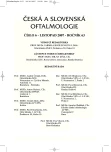Posterior Capsule Opacification (PCO) Following Implantation of Various Types of IOLs – Part One: The Uncomplicated Course
Authors:
P. Krajčová; M. Chynoranský; P. Strmeň
Authors‘ workplace:
Klinika oftalmológie LF UK a FNsP, Bratislava
prednosta prof. MUDr. P. Strmeň, CSc.
Published in:
Čes. a slov. Oftal., 63, 2007, No. 6, p. 379-389
Overview
Purpose:
Despite of decreasing incidence of the PCO, this is still a major and frequent complication of cataract surgery and IOL implantation. Therefore, in our Department, we pay currently intense attention to the PCO problem. The introduction of EAS 1000 in October 2001 allowed us to analyze exactly the relevant PCO issues and our attitude toward its treatment as well. The purpose of our study was to compare the PCO degree in eyes with implanted either PMMA IOLs with round edges or hydrophilic acrylate IOLs with sharp edges. Four types of IOLs were compared in our trial.
Materials and methods:
In the Department of Ophthalmology, Comenius University and Faculty Hospital, Bratislava, Slovakia, the PCO development was analyzed in patients operated on due to senile cataract between November 14th 2001 and April 10th 2003. Eighty-two eyes of 77 patients were followed-up from November 2001 till April 2006. During the 36 months’ follow-up, 82 eyes of 77 patients were enrolled in this study.We evaluated the PCO at day 1, week 1 and 3, 6, 12, 24, and 36 months after the cataract surgery. In all patients, the best visual acuity was assessed. The photographs of the posterior capsule in retro-illumination in the widest possible mydriasis were obtained and evaluated by means of EAS 1000.
Results:
Our study revealed significant influence of the optic material and the type of the implant edge on the PCO development. We did not find any correlation between the visual acuity and the transparency of the posterior capsule. The incidence of Nd:YAG-laser capsulotomies was similar in the two compared IOL groups (PMMA round edged vs. hydrophilic acrylate sharp edged IOLs). We also did not find any correlation between the size of area evaluated and the posterior capsule transparency.
Conclusion:
In our experience, EAS 1000 (NIDEK) has proved to be a suitable device for the follow up of the PCO development following various IOLs types implantation in both experimental and clinical setting. Standardized and objective evaluation systems based on the retro-illumination photography are needed. Despite a certain possibility of examiner-related error of measurement, EAS 1000 (NIDEK) is an accurate device for PCO evaluation.
Key words:
posterior capsule opacification, intraocular lens, EAS 1000 eye analyzing system, polymethylmetacrylate, hydrophilic acrylate
Labels
OphthalmologyArticle was published in
Czech and Slovak Ophthalmology

2007 Issue 6
Most read in this issue
- Opacification of Hydrophilic Acrylic Intraocular Lenses
- Dry Eye Syndrome in Rheumatoid Arthritis Patients
- Correlation of the Heidelberg Retinal Tomograph, Evaluation of the Retinal Nerve Fiber Layer and Perimetry in the Diagnosis of Glaucoma
- Posterior Capsule Opacification (PCO) Following Implantation of Various Types of IOLs – Part One: The Uncomplicated Course
